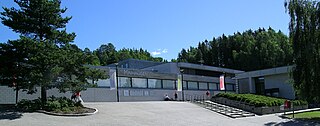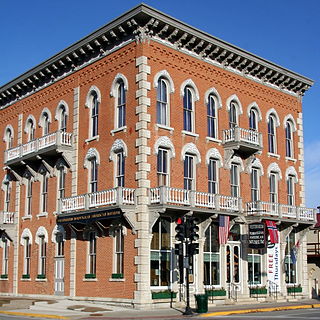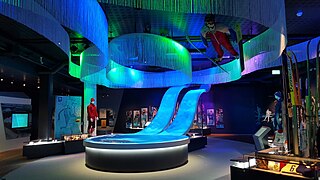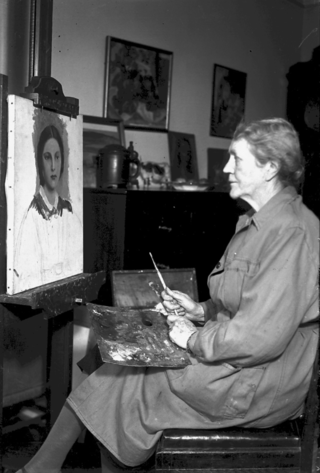
Lillehammer is a municipality in Innlandet county, Norway. It is located in the traditional district of Gudbrandsdal. The administrative centre of the municipality is the town of Lillehammer. Some of the more notable villages in the municipality include Fåberg, Hunderfossen, Jørstadmoen, Vingnes, and Vingrom.
Snøhetta is a Norwegian architectural firm headquartered in Oslo, Norway.

Maihaugen is one of the most visited tourist attractions in Lillehammer, Norway. Maihaugen, with close to 200 buildings, is one of Northern Europe's largest open-air museums and is one of the largest cultural facilities in Norway.

Vesterheim Norwegian-American Museum in Decorah, Iowa is the National Norwegian-American Museum and Folk Art School, with over 33,000 artifacts, 12 historic buildings, and a library and archives. This treasure showcases one of the most extensive collection of Norwegian-American artifacts in the world and highlights the best in historic and contemporary Norwegian folk and fine arts. Some of its buildings are on the National Register of Historic Places.

Lysgårdsbakken, officially known as Lysgårdsbakkene Ski Jumping Arena, is a ski jumping hill in Lillehammer, Norway. It consists of a large hill, with a K-point of 123 and a hill size of 138, and a small hill with a K-point of 90 and a hill size of 98. It opened in 1993 for the 1994 Winter Olympics, where it hosted the ski jumping and Nordic combined events, as well as the opening and closing ceremonies. After the Olympics, ownership was transferred to the municipal Lillehammer Olympiapark and it has since been used for several FIS Ski Jumping World Cup and FIS Nordic Combined World Cup tournaments, including hosting the Nordic Tournament. It has a capacity for 35,000 spectators and is one of three national ski jumping hills in Norway. In 2007, the large hill was rebuilt to a larger profile, and received a new plastic lining. The venue sees 80,000 annual jumps in the winter and 20,000 in the summer season.

The Kunstmuseum Liechtenstein is a state art museum in Vaduz, Liechtenstein. The building by the Swiss architects Meinrad Morger, Heinrich Degelo and Christian Kerez was completed in November 2000. The museum is a collection of international modern and contemporary art and the national art collection of the Principality of Liechtenstein. In 2015, the new Hilti Art Foundation exhibition building was added to the Kunstmuseum.
Kjetil Trædal Thorsen is a Norwegian architect. In 1987, he co-founded the architecture firm Snøhetta.

The Kunstmuseum Basel houses the oldest public art collection in the world and is generally considered to be the most important museum of art in Switzerland. It is listed as a Swiss heritage site of national significance.

The 2016 Winter Youth Olympics, officially known as the II Winter Youth Olympic Games, took place in and around Lillehammer, Norway, between 12 February and 21 February 2016. They were the fourth Youth Olympic Games and the second winter edition. Lillehammer was awarded the games on 7 December 2011 as the only candidate. The games reused venues from the 1994 Winter Olympics; this made Lillehammer the first city to host both regular and Youth Olympics. In addition to Lillehammer, sports were contested in Hamar, Gjøvik and Øyer.

Norwegian Olympic Museum is located at Maihaugen in Lillehammer, Norway.

Jakob Weidemann was a Norwegian artist. Jakob Weidemann is regarded as one of Norway's more important artists of post-war Modernism. Weidemann's work Storfuglen letter (1959) was selected as one of the twelve most important Norwegian artworks by Morgenbladet.

The 1994 Winter Olympics were held in and around Lillehammer, Norway, from 12 to 27 February 1994. Ten competition and fourteen non-competition venues were used, most of which were subsequently used for the 1994 Winter Paralympics. The Games were spread out over ten venues in five municipalities in two counties, Oppland and Hedmark. Lillehammer, with approximately 25,000 inhabitants, and Hamar and Gjøvik, both with approximately 27,000 inhabitants, are all situated on the lake Mjøsa. Gjøvik and Hamar are 45 and 54 kilometers south of Lillehammer, respectively. Hunderfossen is 15 kilometers (9.3 mi) north of Lillehammer, but located within the municipality. Øyer and Ringebu, each with just under 5,000 inhabitants, are 18 and 50 kilometers north of Lillehammer, respectively, in the valley Gudbrandsdalen. Lillehammer had four competition venues, Hamar had two competition venues, while Hunderfossen, Gjøvik, Øyer and Ringebu had one competition venue each.

Nuuk Art Museum is a local museum in Greenland, located in Nuuk, the capital. The museum contains a notable collection of paintings, watercolors, drawings, graphics, figures in soapstone, ivory, and wood, with many items collected by the businessman Svend Junge. Of particular note is a collection of over 150 paintings by Emanuel A. Petersen.

The National Gallery is a gallery in Oslo, Norway. Since 2003 it is administratively a part of the National Museum of Art, Architecture and Design.
Lillehammer Olympic Village was an artificial village constructed in Lillehammer, Norway, to accommodate 2,300 athletes and leaders during the 1994 Winter Olympics, and subsequently a smaller number during the 1994 Winter Paralympics. The Hamar Olympic Subsite Village was in Hamar; part of Toneheim Folk High School, it was able to accommodate 500 athletes and leaders.

Storhove is a neighborhood of Lillehammer, Norway, located 5 kilometers (3 mi) north of the city center. It is the location of a Inland Norway University site, and the Lillehammer offices of the Norwegian Broadcasting Corporation. During the 1994 Winter Olympics, it also hosted the International Broadcasting Center and the Main Press Center.

Alice Dagny Pihl Salvesen (1869–1959) was a Norwegian painter. In 1894, she was one of ten artists who participated in the Vågåsommeren artists' colony in Vågå, Innlandet County. She was principally a portrait painter but also created mood paintings, landscapes and interiors.

Johanna Bugge Berge (1874–1961) was a Norwegian painter, illustrator and church decorator. In 1894, she was one of ten artists who participated in the Vågåsommeren artists' colony in Vågå, Innlandet County. After marrying Rikard Berge in 1908, she illustrated several of his books with subjects from Norwegian folklore. In 1927, she performed extensive decoration work in Lunde Church in Nome, Telemark.

Ragnhild (Lalla) Hvalstad (1875–1962) was a Norwegian painter and ceramist. In 1894, she was one of ten artists who participated in the Vågåsommeren artists' colony in Vågå, Innlandet County. After painting portraits, interiors and landscapes, in 1922 she changed her focus to ceramics, studying in Faenza, Italy. On returning to Norway, she opened her own workshop in Bestum where together with Lili Scheel she created a wide variety of pottery, frequently decorated with flowers and fruits.
Ellinor (Lilla) Dagmar Flor née Bjærshol is a Norwegian textile artist. Inspired by folk art, her designs have principally focused on women's hats and costumes, frequently combining knitting and embroidery. She has also created church textiles and fabrics for furniture. For her success in renewing Norway's interest in knitting, in 1992 she was awarded the Jacob Prize. Flor is considered to be one of Norway's most distinctive clothing designers. Her works are in the collections of a number of museums, including Norway's National Museum.
















